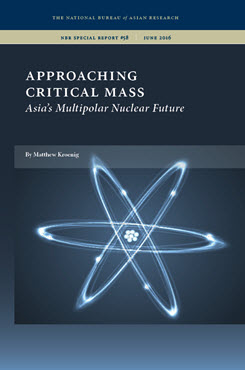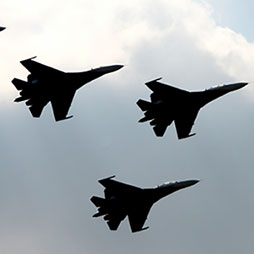NBR Special Report no. 58
Approaching Critical Mass
Asia's Multipolar Nuclear Future
This report explores the dynamics of a multipolar nuclear order in Asia and assesses the implications for U.S. foreign and defense policy.
EXECUTIVE SUMMARY
MAIN ARGUMENT
Nuclear multipolarity in Asia poses a number of unique challenges for U.S. national security, which are often novel from similar problems faced under conditions of nuclear bipolarity. As defined in this report, a multipolar nuclear order is simply an international system in which multiple nuclear-armed states regularly interact. Asia is defined here broadly as stretching from East Asia to the Middle East. The most important and fundamental differences with the Cold War are that, at present, the major nuclear-armed states each have multiple nuclear-armed adversaries, and these competitor states are not aligned with one another, meaning that each power must take into account, and tailor policies to address, distinct and often overlapping strategic dynamics. The U.S. faces heterogeneous dangers from Russia, China, and North Korea. Russia must be concerned with distinct nuclear threats from both China and the U.S. China confronts manifold challenges from the U.S., Russia, and India. And India must deter unlike nuclear threats from China and Pakistan. There are other differences as well, each with specific implications for nuclear strategy and posture, arms races and arms control, escalation, extended deterrence and assurance, and proliferation.
POLICY IMPLICATIONS
- In a world with multiple nuclear adversaries, U.S. officials and strategists need to move away from thinking about a single nuclear strategy or posture and toward a model of separate strategies, postures, and capabilities for each potential adversary.
- Washington needs to understand that changes to its nuclear posture and strategy can have widespread effects throughout the system and consider more creative arms control agreements that encourage restraint between states in different positions in the international system, lock in asymmetric capabilities, and place limits on unlike capabilities.
- To effectively extend deterrence in East Asia and assure regional allies, the U.S. must continue to maintain a clear advantage in strategic capabilities over potential regional adversaries.
- To contain the dangers unleashed by nuclear multipolarity, Washington must hold the line on future nuclear proliferation in the region and, where possible, take proactive steps to roll back existing nuclear capabilities.
Matthew Kroenig is an Associate Professor in the Department of Government and School of Foreign Service at Georgetown University and a Senior Fellow in the Brent Scowcroft Center on International Security at the Atlantic Council.



